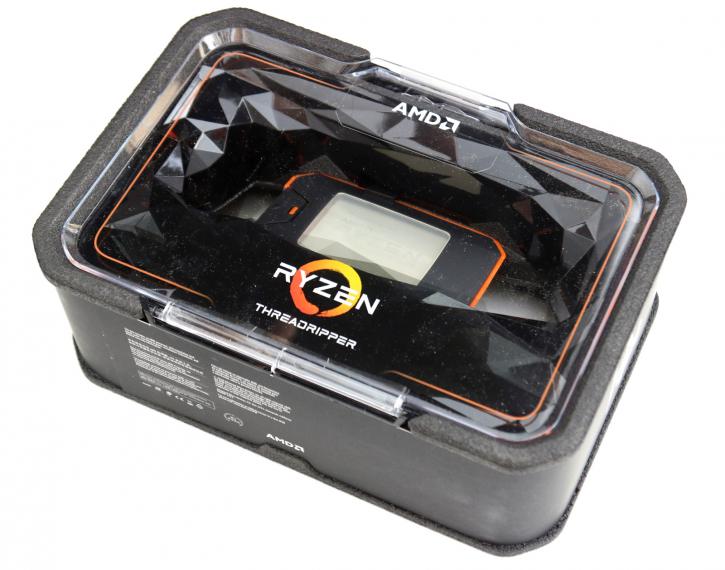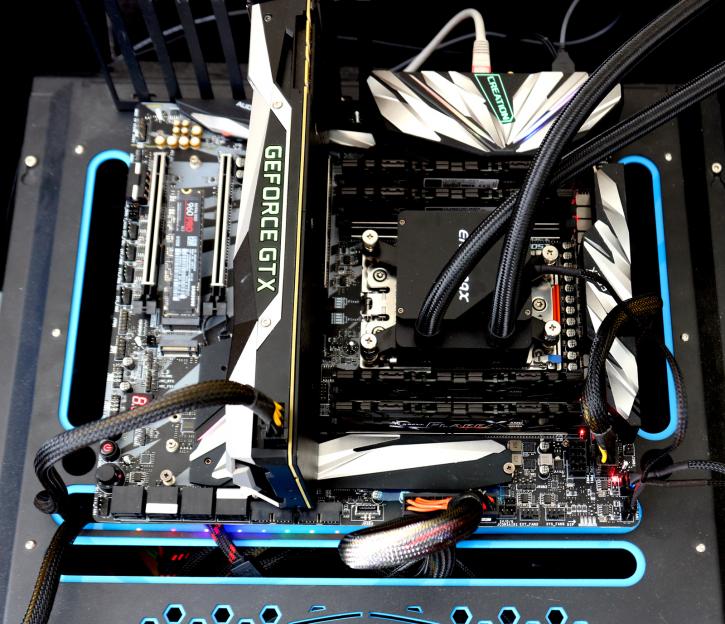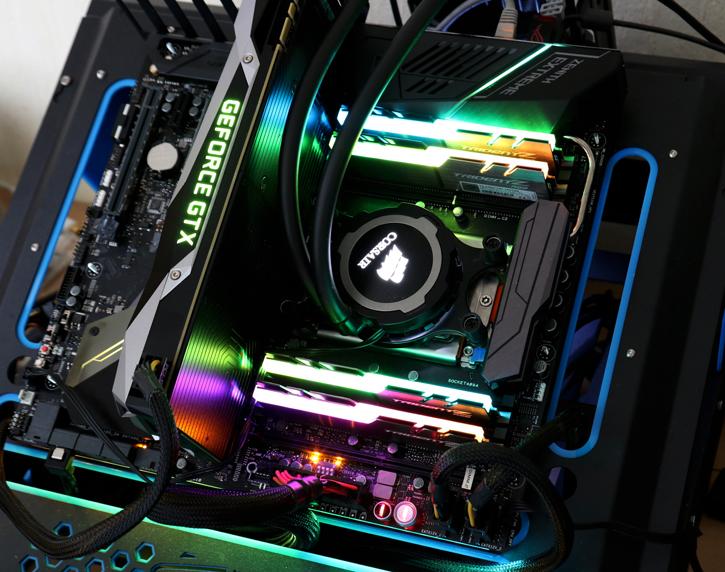HEDT, or 'High End Desktop' Builds
HEDT, 'High-End Desktop' Builds
There has been no segment, perhaps, that took as much disruption from Ryzen's release as HEDT. Back in the day, not far off $2000 netted you 10 cores on the LGA 2011-V3 socket. Now, from Intel, it buys you the 18 core/36 thread 9980XE. From AMD, we have the 2990WX at around $1,700, offering 32 cores/64 threads. Yes, I am well aware that the 2990WX might well be in a class of its own due to the very specific 'WX' terminology, designating it as a workstation CPU specifically. Therefore, the 'closest' competitor to Intel's 18 core monster is the 2950X, which can be had - right now - for $850... yikes. I have also built systems with Intel's i9 7900X, and that is also really rather good. To be quite frank, I could finish the article here and say this:
'If you are buying a PC of this calibre, then you already likely know what you need. Therefore, CPU options from either Intel or AMD can serve you well, and it depends entirely on the applications you are running.'
Do you still want advice? Well, ok, read on.
Is there anything else of note, then? Well, yes. Intel's just released 28C/56T Xeon 3175X. By all accounts, despite packing 4 fewer cores than AMD's 2990WX, the extra frequency and single die configuration lead it to be faster in most scenarios. Sometimes by a little, sometimes by more than a little. This wasn't a huge surprise to me, as the 2990WX is very fast, but only when it is suited to the workload thrown at it. I suspect the arrival of Zen 2 will seek to alleviate these problems.
We now have, therefore, the following situation. If you want to equate price, then the 2950X (16C/32T) is around the same as Intel's 10C/20T. If you want to match core for core, then Intel's 9980XE comes in at around $1,000 USD more than the 2950X. AMD then offer 32C/64T at around £1650, whereas Intel offer 28C/56T at a lot more. Surprised? You probably shouldn't be, as this has been the way of things for quite some time. This is, partially, why Zen 2 is such a prospect. For the first time that I can remember, AMD decided to match Intel core for core, and show off Zen 2 at 8C/16T against the 9900k. They could have just gone all out, but they chose to hold back. Just an oberservation.
Ignoring the price, again, we are in a situation where formerly server core count CPUs are available to the average person. They're not cheap, sure, but they are not the astronomical prices of enterprise grade chips, either. For just under two years, that is progress.
Anyway, if you are in the market for these HEDT chips, what can you do? Well, the first thing to remember is that the highest end of Intel and AMD's 'Desktop' platform (i.e. LGA 1151 and AM4) both feature 8 core, 16 thread CPUs that are entirely happy functioning as more entry-level workstations as they are functioning as gaming machines. If you don't need 8+ cores, then save the money. The 2700X and 9900k (as well as the 8700k/9700k) are entirely happy as dual-purpose computers.
If you do, however, need a lot of cores, then what is your best option? In my last variant of this article, Intel's X-Series 9000 chips weren't a thing, but not enough has changed from them for anything I said previously to be any different. It really, really depends on who you are, how much money you can spend, and what applications you use. With that, read on.
Processor choice - AMD
AMD still has a lead in the core count war, although the 3175X does beat the 2990WX at its own game for a fair (if not most) number of use cases. I suspect the hex-channel memory and monolithic config are playing their part, here. However, the price difference is a major factor, as is availability and ease of purchase. More on this later. AMD's Threadripper 2 line up is about to expand further, adding 12 and 24 core 'WX' designated (i.e. Workstation orientated) CPUs to the lineup. The 12 core is a replacement for the excellent value 1920X of yesteryear, and the 24 core part is, potentially, a nice little stopgap between the 2950X and 2990WX.
For now, however, let's focus on the 2950X and 7980XE/9980XE. The price differential between these two CPUs is, quite simply, staggering. The 2950X can, right now, be had off Newegg.com for just over 850 USD. The Intel chip, which carries two more cores, commands a near 1,000 USD premium. Remember, this is not 'old' Threadripper. This is Pinnacle Ridge based 12nm Threadripper. Coming in at a 180W TDP, the 2950X contains 16 cores, 32 threads, and has support for 64 PCIe lanes, as well as quad channel memory. Naturally, one can overclock the whole chip, but you will see a fairly major spike in power consumption. For some, that'll be worth it. For others, not so much. Actually, in fact, scratch that. I highly suggest NOT overclocking your workstation CPU, unless you 100% know what you are doing. If you are going to overclock, keep it light? 4Ghz across all cores will see a healthy performance boost, though I would argue the tuning of memory on Ryzen is actually more important.
If you have software that can truly take advantage of 16 cores/32 threads, then the 2950X is an excellent CPU. Naturally, when compared to its higher clocked Intel counterparts, it will suffer in gaming as well as programs that still prefer higher clock rates or single core performance. However, if you are buying into X299 or X399 for gaming, you're doing something wrong. Go away, and come back with an 8700k/9700k (or 2700X), and you'll save a tonne of money for better performance.
Realistically speaking, the 2990WX is a relevant product for only a few people. Windows still has trouble really taking advantage of such a high thread count (a fact which became painfully obvious where re-testing of said CPU was done in Linux based operating systems. By comparison, for 850USD, the 2950X is a godsend to those wanting high end and high core count computing from the comfort of their own home. Just because the 2950X comes in at below 1000 USD certainly doesn't mean a PC based around it will be cheap, but I was able to select a CPU, motherboard, RAM, and cooler for the same price as the 18 core Intel part on its own. I'll let that sink in.
I'll make it clear. The value for money that the 2950X represents is, quite simply, approaching fairy tale level. Sure, the 'equivalent' Intel part will give it a bloody nose in certain things, but they are - otherwise - remarkably close. You have to remember, also... $1000. You have nearly half a system priced out for just the cost of adding the 9980XE to your parts list alone (or even the 9960X). Please also remember that just because we recommend the 2950X does not suddenly make Threadripper 1 obselete! If you can find a deal on, say, the 1950X, then by all means invest in it. It's still 16 cores/32 threads, just with a larger manufacturing node and lacking some optimisations/features of Threadripper 2.
Processor Choice - Intel
On the surface, the choice here is obvious. Intel's 18 core packs all that computer power into a single monolithic die based on their now highly refined 14nm process. However, you have a slight trade off problem, here. Whilst it's safe to say that someone looking at this end of the PC market perhaps isn't lacking in money, $1000 is still a lot of dollars for anyone to consider spending extra, and you still have to buy the board and substantial cooler on top of that. Do you, therefore, look at the similar core count 9960X (which matches the 2950X's 16 cores/32 threads), or similar priced 9820X? The former still commands a $500 USD premium over the 2950X, and loses the 2 core/4 thread advantage held by the 9980XE. The 9920X matches the 2950X's price, but comes to the battle packing 6 fewer cores and 12 fewer threads.
Again, however, this all very much depends on how deep your wallet is, and what you aim to do with your PC. This article could be pages long if I elected to go into the ins and outs of what software and applications prefer cores, and what prefers clocks. However, given that many professionals tend to stick to a fairly narrow range of applications, the choice will be made significantly easier. Both Intel and AMD make excellent products, and it really does come down to measuring performance vs. price vs. relative spend.
Our advice is as follows. Do your research, find out what your chosen suite prefers, and then make a decision based off of that. If you are still stuck, software vendors (such as Adobe) often have fairly comprehensive performance guides as to what their software runs well on, and ideal hardware choices for it. To my mind, CPU choice on the Intel side of things comes down to the sub $1000 USD 9920X, or the $1700 USD 9960X. Except for the absolute highest end user, the near $2000 9980XE does not make much sense, at all. Remember, if your chosen application straight up doesn't scale past a certain number of cores, and prefers clock rate, then by going for the 9920X, you have spent the same money, but gotten better performance.
It's safe to say that in applications that use multiple cores, single core performance falls off the table in terms of being important. Ultimately, I think the current disparity between core count and (for lack of a better term) optimisation/efficiency can be nicely summarised by the battle between Intel's 3175X and AMD's 2990WX. Despite having more cores, the 2990WX loses most of the time, if not all of the time. This comes down to clock speeds, architecture, memory, optimisations, and even the operating system. I should probably say that the 3175X isn't actually, at the moment, a product you can buy, leaving this battle in the 'on paper' category, more than anything else.
Motherboard - AMD
This is, really, the last segment in this article that strictly relates to what we recommend. A good motherboard is now more important than ever, in the HEDT space, given the extra power these CPUs require, as well as the potential need for the end user to expand their PC with PCIe expansion cards, higher end networking, PCIe based storage, and so on. To that end, we do have some 'favourites' in the X299 and X399 motherboard space, so read on below.
For AMD Threadripper, there are two schools of thought, and they very much depend on whether you wish to go for the 'daddy' 2990WX, or keep things a little more sane with something like the 2950X, 1950X, or the 12/24 core chips. Whilst all boards are going to be offering you excellent connectivity and build quaity, of real concern is the ability of the VRM to cope with the massive power demands of Threadripper. To that end, if you wish to opt for the 2990WX, we have two recommendations:
The first is MSI's 'Meg' X399 Creation. This is, quite, simply, a motherboard made for Threadripper 2. It has a simply preposterous (a word which I do not get to say that often, which is a shame) 19 phase VRM design. This, on its own, nearly justifies the near 500 USD price tag. If you want to know more, please read the review, linked here. Suffice to say that the board was able to achieve an all-core OC of 4.01Ghz using 1.35v. The VRM, when highly stressed (remember, 32 cores at 4Ghz), reached a peak temperature of just 84.9C. This is well within the safe limits of a VRM such as this, and was truly impressive. To be honest, though... just leave the 2990WX to its own devices? If only for the sake of your power bill, as system power consumption with the 2990WX at 4Ghz reached over 700W.
Our second recommendation is Asus' ROG Zenith X399. Despite being a board designed for the last generation of Ryzen Threadripper CPUs, Asus' over engineered the VRM to such a degree that it can, in fact, handle the 32 core 2990WX. Add to this that Asus have offered a free VRM upgrade kit in the form of an active cooling solution, and you can feel reasonably safe in installing a 32 core, 250W TDP behemoth into your Zenith board. The review of this board can be found here, but please bear in mind that it was conducted with the previous generation 1950X, and not the 2950X or 2990WX.
What about if you don't want to try and tame 32 cores of 12nm power? Well, luckily, and as we have seen, previous generation boards can happily support the new TR4 chips by means of a simple BIOS flash. Easy. So what do we recommend? Well, in short, you really wouldn't go wrong with the above ROG Zenith Extreme. It's the flagship board and glamour girl of perhaps the entire previous generation, but there are other options.
One such option is Aorus' take on X399, with their Gaming 7 offering. The article is here, but we were impressed in several ways. Memory support was solid straight off the bat, allowing for the tested 3200Mhz CL14 kit to boot into Windows first time, without issue. The BIOS, even initially, was solid. The overclocking was equally satisfying, allowing for that familiar 4Ghz using 1.35v on all cores. It well earned our 'Top Pick' award, and Hilbert rightly stated that whilst 'it's no Zenith,' it's also half the price.
Motherboard - Intel
For Intel, we again have to use a 'scale', depending on what CPU you're using. To be clear, each motherboard on the X299 platform will very happily handle a 9980XE or 9960X. At stock. Should you wish to overclock your HEDT CPU, then that 'scale' becomes entirely relevant. Starting off the list, we have MSI's X299 Gaming Pro Carbon AC. At the time of review, X299 was very immature, leading to BIOS issues and generally lacking gaming performance. Now those issues are behind us, objectively speaking the above product is a very tempting offering for those wanting to invest in the lower to mid-end of X299 and Skylake-X. It's not the cheapest board on offer, but when you are paying nearly 1000 USD for your CPU, money clearly isn't much of a problem? Good features, excellent build quality, and a solid UEFI. What's not to like? For those interested in a far more in-depth analysis than what I have just offered, please take a gander at Hilbert's review here.
To round things off, then, what do you if you want the higher end of the Intel product stack? First up, you're potentially paying north of 1400 USD for a processor. I've said it before, but - for you - money clearly isn't a problem. Therefore, you may as well pair your CPU with the very best that the X299 lineup has to offer. In this case, it comes in the form of the Asus X299 Rampage VI Extreme (I think 'Rampage' might be a reference to the obliteration your bank balance will undergo?). I highly recommend, as always, taking a look at Hilbert's in depth review, linked here. Coming in at just shy of 600 EUR, the board is as expensive as some lower mid-end gaming builds are. However, 'lacking' isn't an accusation you can level at this thing, coming in and packing pretty much every single nicety that one can imagine. It looks, I think objectively speaking, fantastic, for one. For two, the build quality, connectivity, and VRM quality are second to none in the X299 lineup. If you want to buy a 16 or 18 core Intel CPU, then this is your only choice. Period.
Cooling
Since we are into the high end of CPUs, here, nothing but the best will do. In the case of Intel X299, we have varying recommendations based on how many cores your chosen CPU has. For up to the 12 core 9920X, we recommend at least a 280mm AIO. This will be more than enough to keep the CPU in check at stock settings. However, if you decide to overclock, please be prepared for significantly higher power consumption, as well as a much hotter running processor. I would recommend either leaving the CPU at stock, or really being sensible with your all-core overclock, and settling for a fairly light boost.
If you are wanting a higher core count chip, then I am straight up telling you to opt for a 360mm AIO. Luckily, one does not need a huge ATX full tower case to accomodate a 360mm cooler, anymore, which should be of some comfort to those with more limited room space. A 360mm AIO really should be your starting point, and if you were to elect to custom cool your CPU with waterblocks and dedicated loops, I wouldn't blame you. I do not recommend you 'de-lid' your CPU, at all, as this will straight up void the warranty and always has the potential to go horribly wrong, leaving you with a $1000 USD+ silicon brick.
Our advice on the AMD side of things is both easier to give, and harder. Given the simply massive IHS found on Threadripper CPUs, coolers made specifically to cover the massive CPU surface area are nearly a must. Noctua's excellent NH-U14S TR4 does a staggering job at cooling the 1950X overclocked to 4Ghz on all cores, resulting in 82C. This is a fair bit warmer than most would likely be comfortable with, but remember that the 14S is a single tower 140mm air cooler, and it's suddenly very impressive. Enermax also do a range of TR4 specific AIOs, which you should look into if you are looking overclock your TR4 processor, or simply keep it as cool as possible. Given the advantages of XFR2 and PBO, we would suggest using an AIO to achieve the max possible clocks when using PBO and XFR2.
RAM
This is a fairly simple one. Find out how much RAM you'll need, buy it. Naturally there are different vendors of memory kits, but generally, you will be ok in sticking to the higher-end offerings from the likes of Crucial, Corsair, Team Group, AData, Kingston, and so on. Picking a kit that uses the high-quality Samsung B-Die DRAM chips is essential for getting the best memory performance out of AMD Threadripper CPUs, given the very construction of them relies on fast memory clocks for the infinity fabric interconnect.
I would generally recommend to get the best memory you can get your hands on at this point. Sure, paying extra for kit's of memory that you know are packing Samsung B-Die chips might sting a little, but I would venture it'll sting a lot less than not getting your memory running properly, and then realising that you're leaving performance that you paid for on the table.
Graphics Card
Perhaps the most 'get what you need' section of this list, the GPU choice in an HEDT build will depend on what applications you are running. Photoshop - depending on what files/sizes you are working with - and other photo editing applications can get by, quite happily, with a fairly mid-range GPU (i.e. 580, 1060, something in that ballpark). Photo editing is highly CPU bound, and the lack of GPU accelerated effects means that your main limiting factors are going to be your CPU and RAM.
If you are, however, doing work that really utilises a GPU heavily, then you have many an option. You'll also be pleased to know that you definitely don't need a Quadro. Again, it will depend on how much GPU horsepower you need, and what program you are using. I don't feel qualified enough to offer specific advice in this segment, because the most I do with my PC is game, and edit photos for the reviews I do. However, remember I mentioned Nvidia's new RTX Titan in the previous page? Well, it gets mentioned again now due to the massive 24GB VRM buffer on offer. Those regularly working with creative apps will testify as to just how much system memory they can consume (generally speaking), as well as how much VRAM certain projects can chew through when heavily layered with effects that can or must be rendered by the GPU. This is, legitimately, a reason for the Titan RTX's existence.
There is also Radeon VII, which I will mention again. 16GB HBM2 is not to be sniffed at, I will say, and the presence of FP64 at 1:2 for (approximately) 3.5TFlops of compute is pretty nice. Again, it's not a 'pro' grade card, so bear that in mind. Hilbert did like Radeon VII, but it has issues. Initial drivers (usually an early AMD GPU release Achilles heel), power draw, and noise. Keep these at the back of your mind, and you'll make the right choice.
The use cases of modern GPUs, of course, go far beyond creative applications and the like, and can be used for deep learning, research, and so on. I am, again, not qualified or clever enough to comment on it beyond that very basic level. Chances are, however, if you are in that industry in the first place, then you know what you need, but might not be 100% up on what is currently available from Radeon or Nvidia.
Final Words
And we're done! I hope you all enjoyed and hopefully appreciated the slightly different direction this 2018/19 builds guide took. It was a solid 3 days work whilst away for New Year, so I hope it's well received. I am aware that some of my points might be controversial, especially in the GPU and CPU segment regarding the high-end build.
- Sign up to receive a notice when we publish a new article
- Or go back to Guru3D's front page




